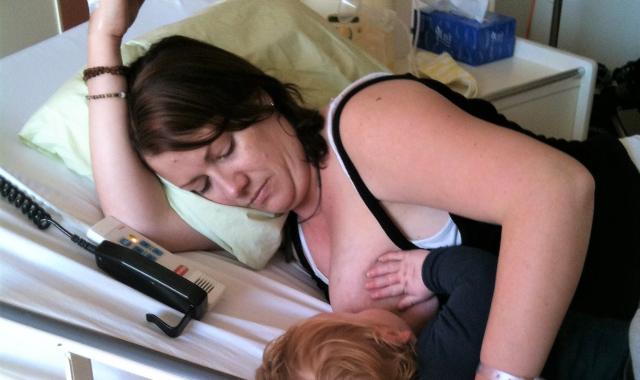An abscess can form in the breast when mastitis isn't treated promptly.

A breast abscess is a build-up of pus (infected fluid) in the breast.
An abscess can form if mastitis isn't treated early enough, or if treatment doesn't work. They are often very painful but can be treated.
With good information and support, you can continue to breastfeed your baby while you receive treatment and recover from an abscess.
What can I expect?
If you are diagnosed with a breast abscess your doctor will discuss treatment options with you.
- The infected fluid may be drained from the abscess over several days using a syringe. This is known as needle aspiration. Sometimes ultrasound is used to guide the needle.
- You may have the abscess surgically drained in a day clinic or hospital. This is known as incision and drainage. Sometimes a drain is inserted into the wound to let excess fluid out, or the wound may be left open to drain naturally.
- You will be prescribed antibiotics to treat the infection.
Breastfeeding with an abcess
Having a breast abscess doesn’t mean the end of breastfeeding. It’s very important to continue breastfeeding from the affected breast during your treatment. Continuing to breastfeed is both safe and recommended.
If your baby can't feed (for example, because you have a drain in the wound which is close to your nipple), you may need to express your breastmilk until the drain is removed.
Some people think the wound can’t heal while milk is leaking from the drain. This is not true. In fact, immune factors in your breastmilk can help with healing and stop further infection. It may be a bit messy if milk leaks from the drain each time your let-down reflex occurs. But you can talk to your doctor about ways to manage this.
Once the abscess has been treated, it can take some time for your breast to return to normal. It will gradually heal while you continue to breastfeed.
The information on this website does not replace advice from your health care provider.
© Australian Breastfeeding Association October 2024
Bartick, M., Hernández-Aguilar, M. T., Wight, N., Mitchell, K. B., Simon, L., Hanley, L., Meltzer-Brody, S., & Lawrence, R. M. (2021). ABM Clinical Protocol #35: Supporting breastfeeding during maternal or child hospitalization. Breastfeeding Medicine, 16(9), 664–674. https://doi.org/10.1089/bfm.2021.29190.mba
Irusen, H., Rohwer, A. C., Steyn, D. W., & Young, T. (2015). Treatments for breast abscesses in breastfeeding women. The Cochrane Database of Systematic Reviews, 2015(8), CD010490. https://doi.org/10.1002/14651858.CD010490.pub2
The Royal Women's Hospital. (2023). Infant feeding - Mastitis and breast abscess - Guideline.
Totadri, V.M., Vetri, R., Sainath, S. (2024). A comparative study of drainage of breast abscesses by conventional incision and drainage vs ultrasound-guided needle aspiration/re-aspiration in a tertiary health care centre. European Journal of Breast Health, 20(3), 194-198. https://doi.org/10.4274/ejbh.galenos.2024.2024-3-2
WA Women and Newborn Health Service. (2023). Obstetrics and gynaecology clinical practice guideline - Breast inflammation and infection: Mastitis and breast abscess. Government of Western Australia, North Metropolitan Health Service.


